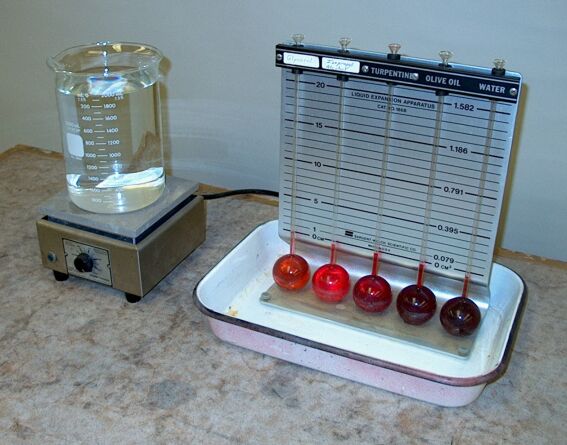
Each bulb in the unit shown above contains a different liquid. When you pour the hot water into the tray to cover the bulbs, the liquids rise in the tubes above the bulbs. When the liquids come to thermal equilibrium with the water, all of them have risen to different heights.
Most materials undergo a change in dimension as the temperature changes. For liquids, we speak of this as a change in volume with temperature, whose magnitude for a particular material is expressed as its coefficient of volume expansion, β (= (1/V)(∂V/∂T)P,n). For our purposes, we may write this as β = (1/V)(ΔV/ΔT). For most materials, this coefficient is positive and does not change significantly with temperature. A notable exception is water, for which β begins to decrease slightly above 4 °C, equals zero at 4 °C, and becomes negative below 4 °C. Water exhibits a density maximum at 4 °C, below which point it expands with decreasing temperature. (See demonstration 48.15 -- Ice bomb.) The expansion and contraction that liquids undergo as the temperature changes is the basis for liquid-in-glass thermometers. The liquid in most such thermometers is usually either mercury (whose coefficient of volume expansion is 1.8 × 10-4/°C) or some type of alcohol, usually dyed red to make it easier to see (coefficient of volume expansion ~1.09 × 10-3 to ~1.49 × 10-3/°C). This kind of thermometer has a small liquid-filled bulb at the bottom, fused to a capillary into which the liquid can expand. As the temperature changes, the height of the column of liquid in the capillary changes. Along the length of the capillary is a scale, usually calibrated in degrees Celsius or degrees Fahrenheit. Because mercury presents a potential hazard if the thermometer breaks, alcohol thermometers have become far more common.
The apparatus above has five bulbs, each of which has a volume of 60 ±1 ml and is connected to a vertical capillary whose internal diameter is 3.175 ±0.005 mm. This gives a cross-sectional area of 7.917 mm2 or 0.0792 cm2. A change in height of 1 cm, then, corresponds to a change in volume of 0.0792 cm3. The plate that supports the thermometers has on it a series of horizontal lines spaced at one-centimeter intervals. On the left side, the 0-, 1-, 5-, 10-, 15- and 20-cm lines are labeled, and on the right, these lines are marked with the corresponding volume (0, 0.079, 0.395, 0.791, 1.186, 1.582 cm3). When the apparatus is not in use, each capillary is plugged with a small rubber stopper. In case the liquids are not all at the same level, perhaps because of a large change in room temperature, before class time the fluid volumes are adjusted as necessary to bring them all to the same level. As noted above, to perform the demonstration you pour water from the two-liter beaker, which has been warmed by the hot plate, into the pan in which the thermometer apparatus sits. This heats the liquid in the five bulbs until they and the water reach thermal equilibrium. The hot plate is set so that the maximum height reached by any of the liquids is safely within the length of the capillaries.
The liquids in the apparatus are glycerol, isopropyl alcohol, turpentine, olive oil and water. The table below gives the coefficient of volume expansion for each of these substances.
Liquid β (1/°C) Glycerol 5.00 × 10-4 Isopropanol 1.1 × 10-3 Turpentine 1.00 × 10-3 Olive oil 7.00 × 10-4 Water 2.14 × 10-4 From the expression for β, we see that ΔT = (1/β)(ΔlA/V), where Δl is the change in height of the column of liquid, and A is its cross-sectional area. The zero line is about 3.3 cm above the tops of the bulbs, which corresponds to a volume in the capillaries of about 0.261 ml, which is within the error specified in bulb volume, so we may take V as equal to 60 ml.
For these liquid thermometers, the lowest measurable temperature is room temperature, or about 21 °C, and the highest temperature measurable without having any of the columns rise above the bottom of the mount (or overflow), is about 46 °C. For isopropanol, a 21-cm rise of the level in the capillary equals a change in volume of about 1.663 cm3, for a ΔV/V of 0.0277, and a temperature change of 0.0277 °C/1.1 × 10-3 = 25 °C. The rises that you observe when you perform the demonstration should at least roughly correspond to the coefficients in the table above. The values in this table are from The Engineering Toolbox and Parchem fine and specialty chemicals (for isopropanol; the isopropanol in this demonstratoin is 70%, but this value should be reasonably close).
References:
1) Resnick, Robert and Halliday, David. Physics, Part One, Third Edition (New York: John Wiley and Sons, Inc., 1977), pp. 466-469.